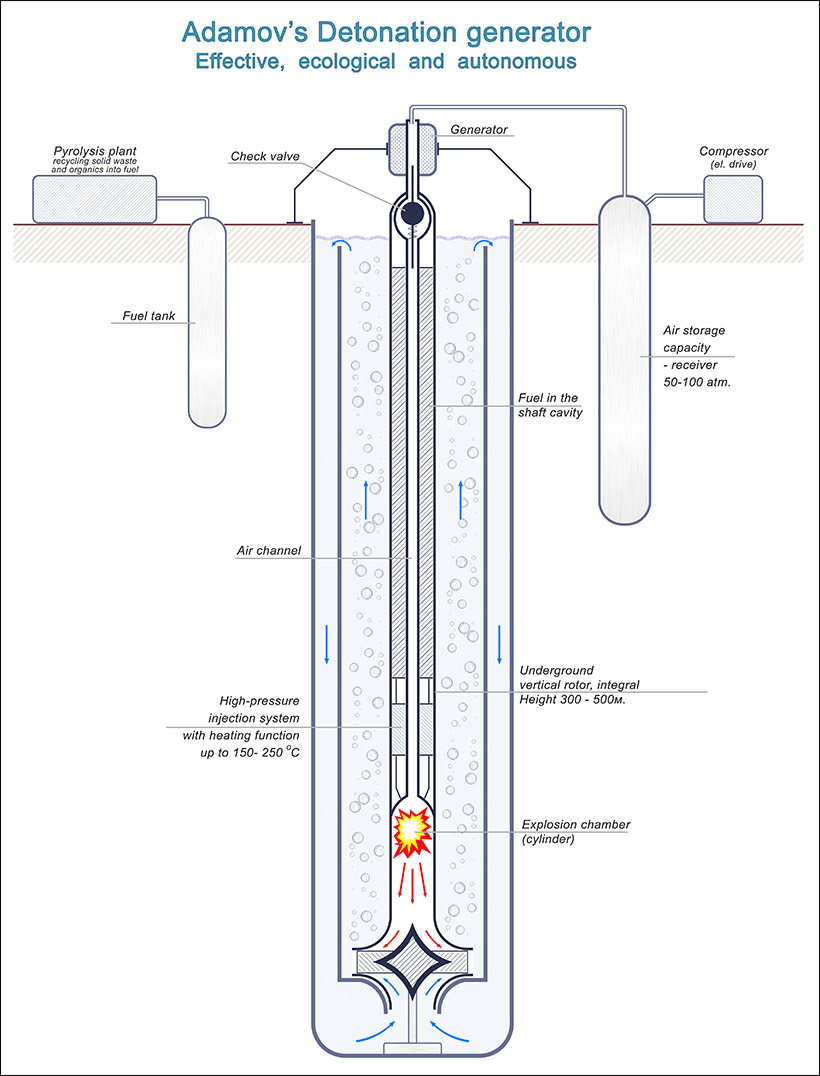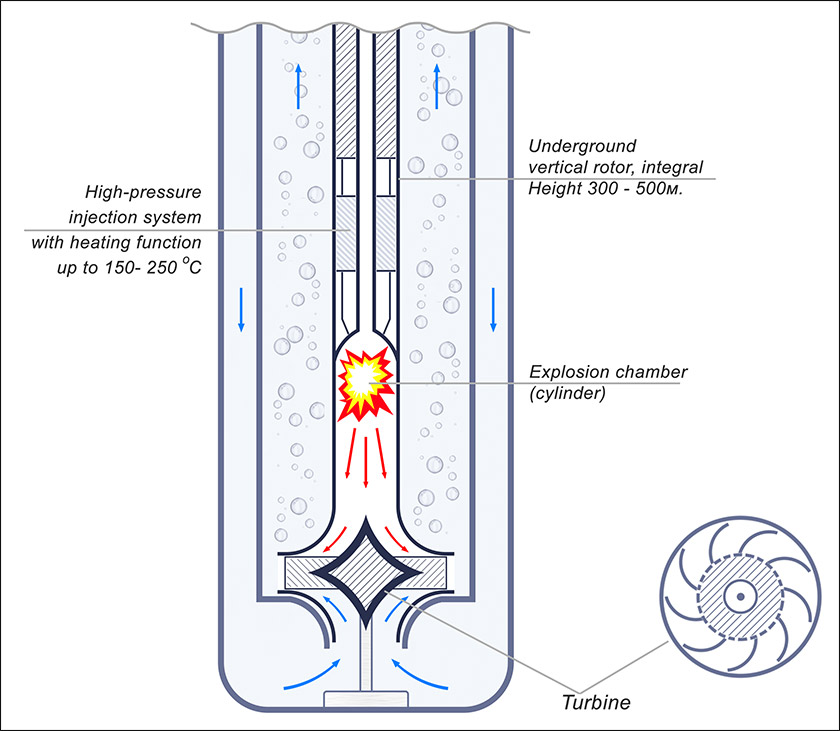Objective: To create a powerful, cost-effective energy system of cogeneration type, without technical clutter and harmful environment effects.
Structure: submersible vertical rotor, combined with combustion chamber and a turbine operating in pairs.
The device comprises the ideas of Oparin, Markelov, Puzanov, Ponurovsky, Adam, and resembles a kind of Clem engine (Segner wheel or turbine).
A distinctive feature of this design is the use of sympathetic detonation shock energy in underwater turbine at maximum efficiency. It should be market that so far we are not implementing this type of "burning" out of peaceful considerations because of supercritical reaction flow. Detonation explosion, even of low power, is in addition to a high temperature (4000 degrees Celsius), also features the incredible destructive shock wave conjugate with ultrasonic and other waves. The use of any mechanical device made of metal has not been implemented to date and is unlikely to be constructed. The first idea – to create a device, where the explosion will occur under water, has settled in my mind long ago, and after some time, following the study of a variety of devices, has acquired quite a completed shape.
To make it easier to perceive the functional content I will give a summary of the method of operation, including the disclosure of novelty and advantages.
Huge capacity itself, which bears a substantially greater efficiency per unit of fuel, can only be tamed in the high pressure water environment – this is the first step to a productive use of energy. The devastating and uncontrollable fire "Yan" can be quenched and converted in the environment of a massive, dense, featuring heat capacity substance – water, presented by "Yin" in the world.
As is known, the efficiency of the internal combustion engine (petrol, diesel) depends on the degree of pre-compression of the fuel-air mixture or air. But after a certain threshold (with compression ratio of 18 and 25, respectively) there is malicious or destructive detonation tough job with the vibration that makes designers to design a compromise solution.
In this case, due to absence of a piston and a mechanical drive, this problem does not exist; therefore the compression ratio can be raised much higher using cheaper fuel in smaller quantities. In addition, the design uses all the excess pressure and all the thermal energy. This is achieved by the creation of a stable imbalance in the water column, containing gas bubbles – the principle of the airlift – which was interestingly applied by Markelov – power generating turbine.
The essence of the invention is to create a flow of water by the difference in weight of typical water and water with the air bubbles pumped by the compressor. The cost of compression should be many times greater than the energy received from the stream if the compression loss is small and the system is balanced. Energy is extracted from the cooling water, which transfers heat to the expanding air. In theory it all fits well – but the fuel-free turbine never worked (or nothing is known to me about it). We are not counting on the fuel-free operation here, though it is not excluded theoretically, we are adding a spark of eureka by offering a good alternative to contemporary generators.
The device is a two-stroke internal combustion engine operating in an aqueous medium: an explosive pressure creates a movement of water-air mixture through the turbine. Flue gas, rising in a vertical pipe, creates the desired constant flow of which is a secondary energy source, using the residual pressure and high exhaust gas temperature. Thus, we use energy much more efficiently, and the explosion is not limited to compression ratio, we do not need a passive cooling system and lubrication. Power and life time must be a magnitude higher than that of thermal machines. At first, the schematic illustration shows a general view of the installation, which clearly demonstrates a few functional differences from the existing generators.

Figure 1.
Underground placement of the huge vertical shaft (shaft) with water and a rotor of epic proportions.
The minimum number of parts and assemblies.
The device does not accept any technological, environmental and other risks; it works exclusively smokeless, quiet and has ultra-efficient fuel consumption.
Let us examine each specification given above.
Large vertical dimension is driven by the need to create a natural (water) piston, which ensures pressure of 30-40 atmospheres (300-400 m). In addition, we have safety and noise damping.
The device consists of a large steel rotor shaft which is a hollow cylinder where explosive reaction occurs through the combination of compressed air and superheated fuel.
After the explosion, the overpressure spins the turbine, and created disequilibrium, thus providing a continuous flow of water with a higher energy output compared to what we have in internal combustion engines.
This design allows to work both in a spark-ignition mode and in the self-ignition mode, as well, most likely, in a pulsating combustion mode (pulsejet). The latter option seems to be the most interesting in terms of the maximum generator power density, which is a crucial feature today, since it makes a major part of the cost of installed unit capacity.
Let’s regard the operation of the device at a more detailed figure 2.

Figure 2.
We have a centrifugal, submersible turbine with two input channels for rotation axis: gas mixture, obtained from the explosion, is fed along the upper, the water moves by the lower and transfer energy to turbine wheel. The movement of water is provided by the difference between the densities of the water in the pipe and the shaft. Cyclic operation of the conditional internal combustion engine is performed in two-stroke mode, but in qualitatively different conditions.
We avoid a row of problems including "a blind spot" – the minimum shoulder crank at the maximum pressure, cooling and overheating, lubricants, compression constraints and composition of the fuel mixture. But the most important thing: we're going to get times more energy per unit of fuel by increasing the temperature difference between the fuel and air – this is the main postulate in Ponurovsky theory, which has offered us a new vision of explosive processes. This works just as it is described in the invention: "The method of operating a supercharged two-stroke internal combustion engine and construction of a two-stroke engine and for its implementation".
Compressed air is supplied from a compressor to a shaft cavity (a cylinder) with a pressure greater than the water pressure in the column (creating a flow of water and air through a turbine), where an overheated fuel is periodically injected and an explosion or detonation is produced. The advantage of detonation is more energy per unit of fuel.
This design can complement the existing powerful generation installations (nuclear, thermal units) in order to use waste heat and excess capacity in the daily chart. To achieve this effect large volumes of air are pumped in special storage at nights, and during the day time the detonation generator is launched in a very modest mode, which allows to regenerate the compression energy and the energy of hot water (invention of Markelov) into the electrical energy, thus gaining extra strength due to the use of detonation energy.
It is also possible to combine the operation f a station with purification of polluted water and desalination units.
If we avoid detonation and deliver pressurized air only we would get the refrigerating appliance, with the generation of the drinking water from air. If the invention of Ponurovskу (the possibility of cost-free cold dissociation of water into hydrogen and oxygen) is confirmed, then this device will turn to fuel-free generator of electricity, cold, fuel and drinking water.
There is another opportunity to explore the capacities of the device using liquid propellants based on ammonium nitrate.
Summary of the detonation method of operation of the generator is as follows:
1. An entirely new way of combining fuel and air is applied, which provides a more efficient release of energy with the opportunity for transition into a detonation regime using heavy and cheap fuels. Methodology of Ponurovsky A.A.
2. A centrifugal turbine is used, which, under certain conditions and speeds, generates a gratuitous energy. (Methodology of Puzanov).
3. The secondary heat energy and residual pressure removal is performed by creating disequilibrium in the aquatic environment. (Methodology of Markelov).
4. The idea and design of Adam – double turbine is working as gas turbine driven from the exhaust gas, and as a hydraulic turbine driven by the rising flow of water.
5. The design versatility allows to create a hybrid cogeneration units to produce heat, electricity, cold water and ice.
The idea is presented here in the most concise form for general guidance. Practical work over the project requires large investments, stage-by-stage engineering work and setting up a pilot version of smaller size as the fuel-air mixture explodes and detonates in any excess pressure thus allowing to setup and run more manageable sizes of the device.
Adamov A.V. Moscow - Yerevan, October 2016.
Related Links:
1. Markelov. Pneumohydraulic turbine.
2. Puzanov. Energy of centrifugal forces of inertia.
3. Ponurovsky. The process of obtaining energy with generation of cold.
4. Nekrasov. Makarov. Gunpowder engine.
5. Adamov. A new physical law.
6. Oparin. Physical basis of fuel-free energy.